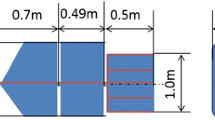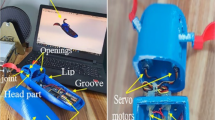Abstract
Balloon robots consist of a balloon body, which is filled with helium to provide buoyancy. In particular, fish-type balloon robots (FBRs) incorporate caudal- and pectoral-fin motions as their propulsion mechanism, which can be combined to realize complex motions. However, the propulsive force generated by the pectoral-fin motion is less, which is a disadvantage, and it is necessary to increase the propulsive force. Since the weight of FBR is limited, it is crucial to select a fin that can generate larger propulsive force at the same weight. In this study, pectoral fins with different shapes and materials are developed, and the propulsive force generated by various fin movements is measured. Finally, the results are compared and discussed relative to the influence of shape and softness on the propulsion.















Similar content being viewed by others
Data availability
The measured data from the propulsive force measurement experiment can be provided. All simulation results presented in this paper can be obtained from this measurement data.
References
Tezza D, Andujar M (2019) The state-of-the-art of human-drone interaction: a survey. IEEE Access 7:167438–167454
Chung SH, Sah B, Lee J (2020) Optimization for drone and drone-truck combined operations: a review of the state of the art and future directions. Comput Oper Res 123:105004
Shimonomura K (2019) Technical aspects of drones: current situation, unsolved issues and prospects. IATSS Rev 44(2):100–107
Kadota H, Kawamura H, Yamamoto M, Takaya T, Ohuchi A (2004) Development of autonomous balloon robot system with vision camera and PD position controller. IPSJ J 45(6):1715–1724
Jojnson JA, Svach MR, Brown LH (2019) Drone and other hobbyist aircraft injuries seen in U.S. emergency departments, 2010–2017. Am J Prev Med 57(6):826–829
Khan A, Brown L (2021) Recreational drone-related injuries in children: a review of national electronic in-jury surveillance system (NEISS) data. Cureus 13:13–17
Haga M, Uchida M (2017) Propulsion modeling of caudal fin driving system on balloon fish robot. Artif Life Robotics 22:10–16
Ishitobi T, Uchida M (2021) Torque estimation for joint protection in balloon robots. The papers of technical meeting on instrumentation and measurement. IEE Jpn 201(61):53–56
Miyamae H, Hori K, Uchida M (2021) Control system using timestate control form for balloon robot. IEEJ Trans Electr Electr Electron Eng 16(3):412–418
Drucker EG, Walker JA, Westneat MW (2006) Mechanics of pectoral fin swimming in fishes. Fish Physiol 23:369–423
Gros S, Zanon M (2020) Data-driven economic NMPC using reinforcement learning. IEEE Trans Autom Control 65(2):636–648
Author information
Authors and Affiliations
Corresponding author
Additional information
Publisher's Note
Springer Nature remains neutral with regard to jurisdictional claims in published maps and institutional affiliations.
This work was presented in part at the joint symposium of the 28th International Symposium on Artificial Life and Robotics, the 8th International Symposium on BioComplexity, and the 6th International Symposium on Swarm Behavior and Bio-Inspired Robotics (Beppu, Oita and Online, January 25–27, 2023).
About this article
Cite this article
Kagiya, N., Uchida, M. Comparison of the relationship between pectoral-fin movement and fin shape based on force index for fish-type balloon robot. Artif Life Robotics 28, 850–858 (2023). https://doi.org/10.1007/s10015-023-00903-w
Received:
Accepted:
Published:
Issue Date:
DOI: https://doi.org/10.1007/s10015-023-00903-w




